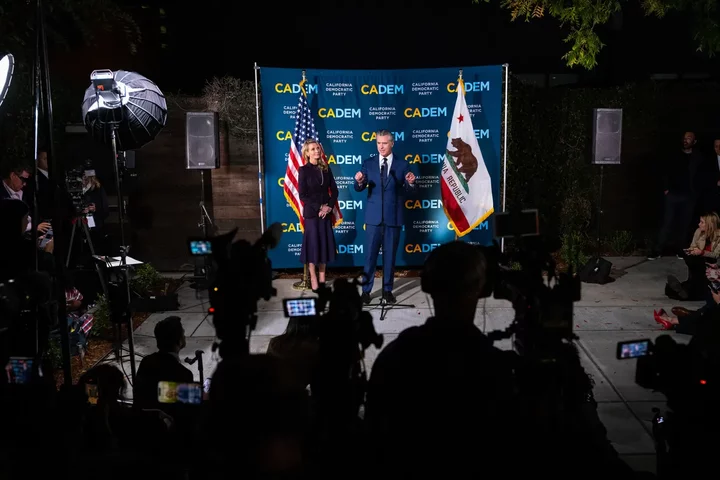Gov. Gavin Newsom speaks to the press, alongside First Partner Jennifer Siebel Newsom, after Proposition 50 was passed by California voters, at the California Democratic Party headquarters in Sacramento on Nov. 4, 2025. Photo by Jungho Kim for CalMatters
###
This story was originally published by CalMatters. Sign up for their newsletters.
###
Gov. Gavin Newsom has a message for Democrats around the country: Follow my lead.
Declaring victory for Proposition 50, his Democratic redistricting ballot measure, he named five other states led by Democrats and urged their governors to tilt their own congressional maps in favor of the party and help it secure the U.S. House in next year’s midterms.
“We need to see other states, their remarkable leaders that have been doing remarkable things, meet this moment head-on as well,” he said. “We can de facto end Donald Trump’s presidency as we know it, the minute Speaker Jeffries gets sworn in as speaker of the House of Representatives. It is all on the line.”
It had the decisive air of a politician claiming the national mantle. And though he nodded to House Democratic leader Hakeem Jeffries’s role, the subtext was clear: Newsom was the one who just delivered the party the likelihood of five new seats in Congress.
With Prop. 50’s overwhelming passage, the governor has vaulted — for the moment — into the role of Democratic favorite in the 2028 presidential campaign. Newsom’s national ambitions have never been veiled, but this year he for the first time acknowledged he’s considering it. Having amassed more than tens of thousands of new donors nationwide to support his ballot measure, he also now has a roster of supporters to call on in a potential campaign.
Cable news shows lit up with mentions of the governor’s success at pulling off the redistricting gambit. MSNBC commentator and former Missouri Sen. Claire McCaskill declared Newsom has “moved to the front of the pack” among potential 2028 Democratic presidential contenders such as Illinois Gov. J.B. Pritzker.
“He’s in the top tier,” said Democratic pollster and strategist Celinda Lake. “It was a really outside-the-box idea, implemented well, implemented fast, united the party. And it also showed he was tough.”
Yet one victory in an off-year election driven by the nationwide mood of angry Democrats decidedly set against Trump does not necessarily predict a future successful campaign. Prop. 50 was purely anti-Trump, and Democratic strategist Matt Rodriguez said Democrats still need an independent vision to win back Congress or the White House.
But looking at possible 2028 contenders, “there’s no question (Newsom is) light years ahead of everyone else.”
“He’s the only one driving his own news,” he said. “Everyone else is like a moth to flame.”
‘Iterating’ a vision and a message
Newsom’s prospects for national prominence weren’t always so bright. For years, he’s been experimenting with how to get attention by confronting Republicans on the national stage, challenging them to debates on Fox News and bankrolling red-state billboards advertising California’s reproductive rights. In 2023 he similarly called on other states’ lawmakers to follow his lead for a constitutional amendment on gun control. No other state joined the effort.
In the first few months of 2025, as Democrats struggled with how to recover from the 2024 loss to Trump, Newsom was podcasting with right-wing activists and mulling their successes. It was the latest in a series of his efforts to try on new political approaches, which the governor frequently describes to reporters as “iterating.”
When Texas Democrats approached Newsom for support over the summer as they tried to fight off a Trump-backed GOP gerrymandering effort there, a counter-proposal from California was considered an extraordinary political risk for the governor.
It wasn’t clear all Democrats in California’s congressional delegation or the state Legislature were on board, let alone a majority of the state’s voters. But by the end of a 10-week campaign, so many people had donated to support the measure that Newsom told them to stop sending money, while two opposition campaigns failed to capture attention with a cohesive message.
“I don’t think I’ve ever seen the entirety of the left of politics in California come together in this way in a campaign,” said Neel Sannappa, an organizer with the left-wing California Working Families Party and chair of the California Democrats’ Progressive Caucus.
A knack for trolling
Newsom succeeded, strategists said, by taking a risk in an almost impromptu way that was well-timed with voters’ mounting alarms about Trump’s deployment of the National Guard to American cities, aggressive immigration raids and redistricting efforts in other states.
It didn’t hurt his own standing that he was also engaging in a social media trolling campaign against Trump, adding to perceptions that he was willing to embrace the brash, unconventional politics that led to the president’s own rise. The posts — often AI-generated, sometimes crude, and always extremely online — have delighted Democrats in a way even skeptical progressives like Sannappa commended.
“He was thrust into the spotlight as a result of this particular situation (with Texas) and I think he made the most of it,” said Brian Brokaw, a strategist who advises Newsom. “One of his greatest strengths is his ability to evolve with changing times and changing dynamics … It’s reflected in the positive results of last night.”
Months ago, Newsom already acknowledged that one day the tweets will get old, and he would need a new strategy.
“We’re iterating,” he said at an August event hosted by Politico. “That’s been the cause of my life.”

CLICK TO MANAGE